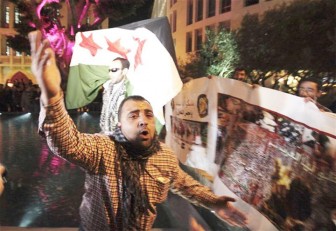By Bernd Debusmann
As Syrian government forces bombard Homs and other cities with merciless brutality, day after day, calls for arming the opposition are becoming louder. But there is a powerful case for caution, and for thinking twice before good intentions pave the road to even worse hell in Syria.

Most importantly, potential armourers of the opposition need to find answers to a number of key questions. The following exchange at a hearing of the US Senate’s Armed Services Committee in mid-February helps explain what is at stake.
Question: “What is the nature of the Syrian opposition? Who are they? How much of this is domestic? How much of it is foreign? What is the regional dynamic? Is al Qaeda involved?”
Answer: “The Free Syrian Army … is not unified. There’s an internal feud about who’s going to lead it. Complicating this … are neighbourhood dynamics. We believe that al Qaeda in Iraq is extending its reach into Syria.” The question came from Jim Webb, a Democratic Senator with a military background. The answer was from America’s spy chief, James Clapper, who added that extremists had infiltrated Syria’s motley opposition groups which, in many cases, may not be aware of the infiltration.
Bombings in Damascus and in Aleppo, Syria’s second city, against government security and intelligence buildings bore the hallmarks of al Qaeda, he said.
In other words, what began as peaceful mass demonstrations against the rule of President Bashar al-Assad almost a year ago (the Arab Spring came to Syria later than to other countries in the region) has morphed into parallel movements of mass protests and an armed insurgency whose composition is not entirely clear. It’s clear, though, that anti-Assad forces are outgunned and outmanned. To significantly increase their firepower would require arms supplies on a scale that would virtually guarantee some of the weapons falling into the wrong hands.
US hawks arguing for arms aid, such as John McCain, the Republican senator, might do well to remember that sizable quantities of the military hardware America supplied to anti-Soviet insurgents in Afghanistan ended up in the hands of the Taliban. That conflict appears to have faded from the hawks’ memories and American interventionists now feel the urge to “plunge in with no plans, with half-baked plans, with demands to supply arms to rebels they know nothing about,” Leslie Gelb of the Council on Foreign Relations, a New York-based think tank, wrote in a column in The Daily Beast.
“Their good intentions could pave the road to hell to Syrians – preserving lives today, but sacrificing many more later.”
‘Friends of Syria’
The number of lives being lost has increased sharply after Russia, the Syrian government’s main arms supplier, and China vetoed a UN Security Council resolution that provided for Assad to step down, hand over power to a deputy, stop killing dissidents and begin a transition to democracy.
The vetoes prompted the formation of a “Friends of Syria” group including the United States, European and Arab countries plus Turkey. They will try to succeed where the Security Council failed – stop Syria from sliding deeper into civil war.
Syria unravelling would not be in the interests of anyone except for al Qaeda, argues Kamran Bokhari, an analyst with the private intelligence company Stratfor, except for. Al Qaeda chief Ayman al-Zawahiri has cheered the anti-Assad opposition and urged Muslims in Turkey, Iraq, Lebanon and Jordan to join the fight.
The violent overthrow of “apostate” regimes is the main plank of al Qaeda’s ideology. Its lack of appeal for the vast majority of Arabs became obvious in the Arab Spring, when people power rather than martyrdom-seeking jihadis brought down authoritarian governments in Tunisia, Egypt and Yemen. In Libya, where the Gaddafi dictatorship ended in violence, it was thanks to the help of the United States and NATO, not al Qaeda followers. Such acts as the Damascus and Aleppo bombings, if indeed they were carried out by al Qaeda militants, serve to keep the conflict going and give Assad, who insists that his government is fighting terrorists, an excuse to crack down even harder. In doing so, he emulates his late father, Hafez. Young Bashar was 17 when Hafez deployed tanks and artillery to flatten the center of the city of Hama to crush a revolt by Sunni Muslims against his Alawite minority regime.
That was in February 1982 and it took 27 days to bomb and shell the city into submission. Estimates of the death toll range from 10,000 to 40,000. No-one was ever held accountable. Hafez al-Assad died in bed, age 69, of pulmonary disease.
His son, 30 years later, is trying to bomb the city of Homs into submission. On Feb 22 alone, two days before the “Friends of Syria” meeting in Tunis, activists inside the beleaguered city reported 80 people killed, including two Western journalists. Grim video clips of hollow-eyed, fear-stricken women and children huddling in shelters touch even the hardest heart. But whether shipping more arms to the opposition is the best way out of the crisis remains open to debate.
World Affairs columnist Bernd Debusmann has reported from close to 100 countries, on stories from the Soviet invasion of Czechoslovakia and the seizure of American hostages in Iran to Lebanon’s descent into anarchy and the withdrawal of Soviet forces from Afghanistan. Debusmann was shot twice in the course of his work — once covering a night battle in the centre of Beirut and once in an assassination attempt prompted by his reporting. (Any opinions expressed here are the author’s own.)





